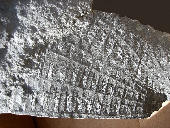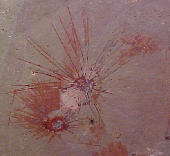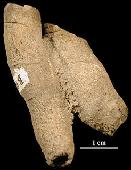|
 See More Images See More Images
(4 total)

Uphantaenia chemungensis
© 2005 R. Weller, Cochise College

Choia utahensis
© 2005 The Virtual Fossil Museum

Lissocoelia
© 2004 UCMP
|
What are Sponges? Sponges form the group Porifera (Latin for “pore-bearing”) and were named for their unique feeding system, which consists of numerous tiny holes that draw in water and food and a few larger holes that expel waste. Generally amorphous animals, sponges are made up of several different kinds of cells that are connected but function more or less independently of one another. For support and protection, they have tiny spines, called spicules, embedded in between their cells. Although the relationships of sponges remain uncertain, they have traditionally been grouped by the composition and type of their spicules. Calcarea have spicules of calcium carbonate, Demospongia of spongin (a protein) and silica, and Hexactinellida have six-rayed spicules of silica. A few sponges live in freshwater, but the majority live in marine environments, from shallow reefs to deep ocean trenches. The fossil record of sponges is patchy, but it extends into the Late Precambrian. First known fossil occurrence: Precambrian. Last known fossil occurrence: Quaternary. This group has living relatives. Cool Sponges links: Search for images of Sponges on Google |
|




